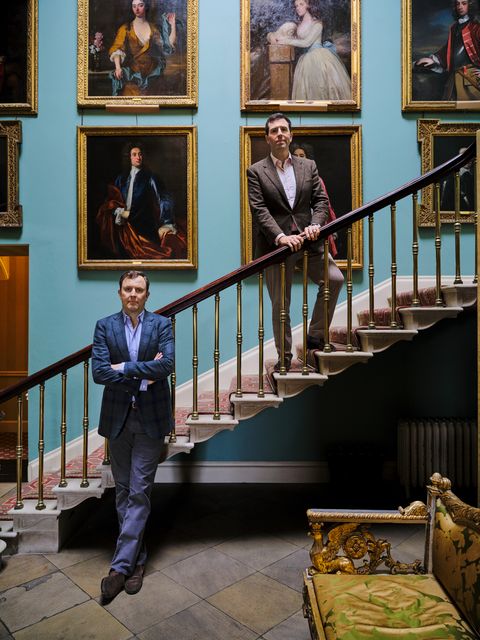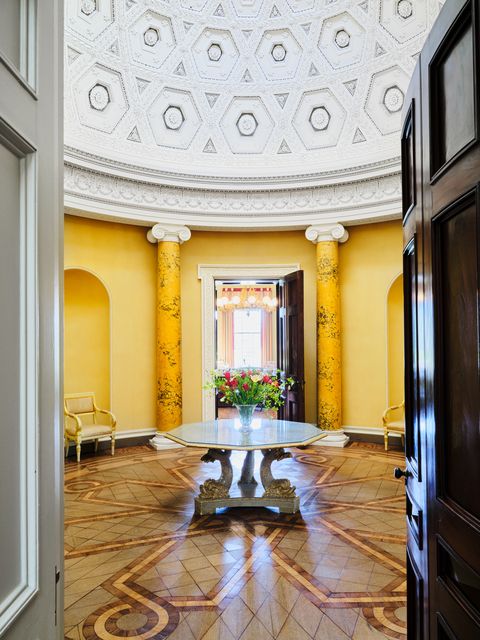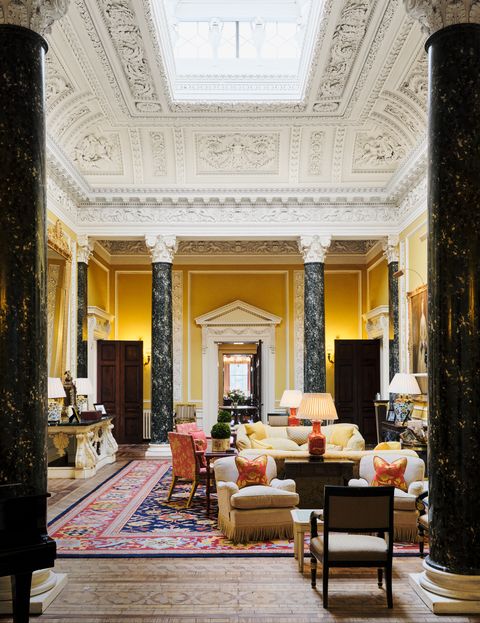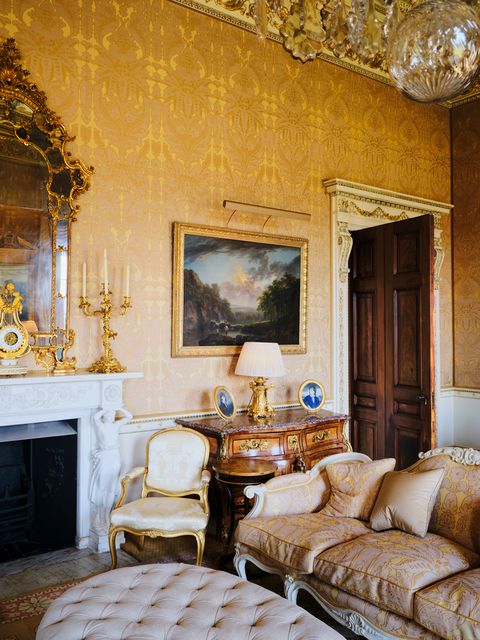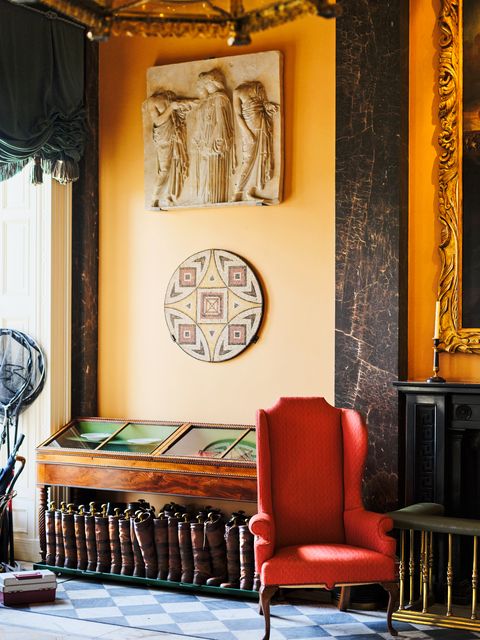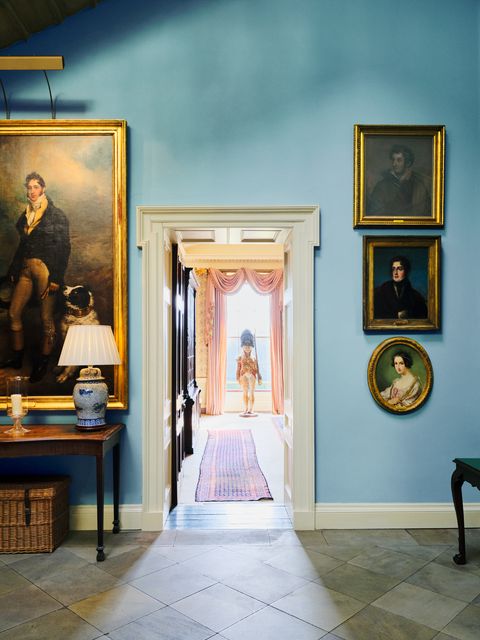Photos of the Irish Manor Ballyfin
As a younger man Jay Krehbiel moved from Chicago to New York City to take a job at the management consulting firm Bain & Company, and when he called home for the first time to share his new address, his father, the electronics tycoon Fred Krehbiel, was horrified. “Lexington,” he said, “isn’t that…fringe?”
Today Jay tells that story not only to gently roast his late dad but to underscore the family’s most recent accomplishment—one that has taken them much farther east than anyone would ever have imagined.
When Fred Krehbiel—who made his fortune in electrical conduits and sold the family business, Molex, to the Koch brothers in 2013 for $7.2 billion—died suddenly in the summer of 2021, he left the bulk of his fortune to his sons, Liam, 46, and Jay, 44. But perhaps more pressing than the matter of Fred’s money was that of his legacy.
Fred had served on the boards of numerous corporations and nonprofits over the years, including the Art Institute of Chicago and the Chicago White Sox, but his most ambitious endeavor in retirement was the restoration of a 19th-century Regency manor some 60 miles southwest of Dublin. The 35,000-square-foot home on 614 acres had most recently been a school before falling into disrepair. Fred spent more than nine years nursing the estate back to life—restoring floors, shopping for period-perfect furniture—before finally opening it as the 15-room hotel Ballyfin Demesne in 2011.
We’re sitting at the hotel bar in late April for the brothers’ first joint interview since their father’s passing. It’s a poignant moment but it comes with, it must be said, a stunning backdrop. Ballyfin is at the end of a mile-and-a-half-long driveway and set against the largest recreational man-made lake in Ireland (a feat of engineering that nearly bankrupted the home’s original owners). And the hotel transformation—which included adding six bedrooms and is rumored to have cost more than $50 million—attracted a wild guest list. George and Amal Clooney rented out the entire property in 2019 for a reunion of George’s Irish cousins. In happier days, Kim Kardashian and Kanye West stayed overnight at Ballyfin on their honeymoon; they presumably enjoyed the gilded plaster ceilings and the chandelier once owned by Napoleon’s sister.
After Fred’s sudden death (he had cardiac arrest in June 2021, a day before his 80th birthday party, and died two days later) some friends and longtime staff members wondered what would become of the property. A regional newspaper, the Leinster Express, suggested that Fred’s death “raised questions over whether the family will stay involved.” It was a reasonable concern. His sons live in Chicago, and both have school age children. Besides, Liam had been very clear about wanting to sell, becoming even more outspoken once the hotel became profitable. “Dad would joke, ‘The fun part was rebuilding it. Now I’m just dealing with personnel issues,’ ” Liam says.
Fun is one word for it, but it’s the kind of fun you can have only if you have a deep love of architecture and even deeper pockets. (In 2015, the Krehbiels were 139th on a Forbes list of wealthiest families in America.) The home was originally built in the 1820s for the Coote family, descendants of Sir Charles Coote (an Elizabethan adventurer who came to Ireland in 1601). The architects were celebrated locals, Sir Richard Morrison and his son William, and they had the perfect client in Lady Caroline Coote, a woman who spared no expense. Her motto was “Cost what it may,” and she meant it. The inlaid floor in the rotunda was modeled on the Alhambra in Granada, Spain.
By the time Fred purchased Ballyfin from the Patrician Brothers, a Catholic teaching order that had run a school on the site, the home’s Victorian conservatory had a tree growing in it and its iron was so rusted the whole thing had to be sent to England for restoration. Meanwhile, the saloon’s ebony and oak floors—built by the queen’s cabinetmaker—lay in pieces in the attic like a jigsaw puzzle. But the new owner was lucky in one sense. As Jim Reynolds, a celebrated Irish landscape architect and Fred’s partner on this project, explains, “The house had not been altered internally since it was first built. Some rooms had the original coat of paint. Knowing that we didn’t have to undo a great Victorianization or Edwardian workover”—basically cleaning up someone else’s bad taste—made all the difference.
Once construction began in earnest, Krehbiel and Reynolds scoured auctions for artwork and silver that had belonged to the Coote family, returning these artifacts to their original home. A series of family portraits, including John Hoppner’s portrait of Sir Charles Coote, which had spent many years in the Virginia Museum of Fine Arts in Richmond, would once again hang at Ballyfin, in a stunning hall with a cantilevered stairwell.
“The thing about the art world,” Jay Krehbiel says, “is that everyone knows everyone’s business.” As word spread about Fred’s new hobby, anything with a Coote provenance “was being taken off the wall and offered to be sold to Dad,” Jay adds. His father often obliged. And like Lady Coote before him, he spared no expense, famously moving a fountain at Ballyfin two feet to the left to align it with the view from the library’s central bow window.
As kids, Liam and Jay often spent summers in Ireland visiting extended family. Their mother Kay is from County Kerry, where the family maintains a home. And she is one of 12 children. As much as Liam loves Ireland, he says that initially he really did want to sell Ballyfin, but after his father’s death he had a change of heart. “I just looked at this place in a different light,” he says, taking in the sight at dusk. “I felt a really strong connection to him.” Upon hearing this, Jay—who manages the family fortune and inherited his father’s love of Irish art—smiles victoriously, as if he expertly played the long game with his brother. “I always wanted to keep it,” he says. “I was just very glad that Liam saw that light.”
The Krehbiel brothers haven’t just decided to keep Ballyfin Demesne, they’ve gone all in. Their father and his partners created a gorgeous living museum; staying here feels much like being a guest in a friend’s 19th-century home, down to the archery and clay pigeons. The task now, it seems, is to focus on more modern guest experiences. Mission one is to reimagine and renovate the lower-level bar room, the lone afterthought at an estate that has been restored to within an inch of its life.
To redesign the bar, which also includes a gorgeous if underused stone patio, the brothers are in discussions with a number of design firms, including Martin Brudnizki Design Studio, the London-based firm credited with reimagining Annabel’s in Mayfair. The hope is to create a perfect spot for a Sunday roast, with construction to begin as soon as this winter.
“I hate the word casual,” says Jay, a self-described snob. But he can appreciate the appeal of a cozy weekend watering hole that reminds him of summers spent visiting cousins in Kerry, enjoying steak-and-kidney pie with a side of live music.
Mission two is a larger endeavor that hints at the brothers’ ambitions. Ballyfin’s eight acres of garden currently supply something like 90 percent of the vegetables for the property’s restaurant, which is run by chef Sam Moody, who earned a Michelin star at the Bath Priory hotel in the English countryside. Every morning Moody sends a WhatsApp message to Ballyfin’s gardeners, ordering up the day’s vegetables and herbs—such as Jerusalem artichokes, sweet corn, garden peas, and microgreens, all cut and hand-delivered.
It’s an impressive operation, and the food is stellar. Moody’s Pork Two-Ways (pork belly served beside a roast loin, with a bit of soy to bring out the sweetness) is a marvel, and I find myself thinking about it weeks later. But Jay envisions pushing the operational side even further, imagining Ballyfin as a spiritual cousin to Blue Hill at Stone Barns but with an Irish brogue. Already the lamb served at dinner is from a farm just five miles away. But what if they produced their own? Jay broached the idea with his father more than once.
“He would say to me, ‘Are you saying that someone’s going to go down and look at Miss Fluffy the pig and then expect Miss Fluffy to end up on the dinner plate that evening?’ I said, ‘That’s exactly what our generation wants.’ ” But Fred, a lover of Diet Coke and Yoplait yogurt, didn’t see it. (For the record, Jay believes Ballyfin is worthy of a Michelin star, saying, “I’m not going to pretend, ‘Oh no, we don’t care about those things.’ ”)
Fred Krehbiel—who enjoyed walking the hotel gardens in the morning—never pushed his sons to join the original family business, Molex, which was founded by their great-grandfather in 1938, perhaps because he had been forced into it by his own grandfather. Fred studied at Georgetown in the 1960s with an eye toward becoming a diplomat, but his grandfather called him home to join the family business. “Dad had total wanderlust,” Liam says. “He wanted to travel the world.” To Fred’s father’s credit, “he realized Dad had interests and talents that didn’t fit the mold of what Molex was then. So Gramps created a role for him to go and follow some of those dreams.”
Fred launched the company’s international division, opening the door to sales in Japan in the 1970s; in the first year, Molex International generated just $54,000 in revenue. Four decades later business had ballooned to over $2 billion, with Molex operating in Mexico, South America, and China, among other far-flung places.
Liam was impressed by his father’s accomplishments, but he figured out early on that Molex wasn’t for him. At 16 he spent a summer interning at the company. “This was pre-internet,” he says. “I was working in the sales department. I manned 10 fax machines. I couldn’t keep up with the stack of papers, the constant chaos, and the fear that I was falling behind. The sales team was furious with me. I gave myself the title of Fax Boy.”
Hearing this, Jay, who actually did a proper two-year stint at Molex after a brief tour at Bain & Company, says, “I think you’ve identified the difference between us—in that I would have been Fax Manager.”
Rules of the Manor
DO NO HARM
Spare future generations having to unmake regrettable choices. “The house was saved,” says Jim Reynolds, who led Ballyfin’s restoration. “It had not been altered internally since it was built.”
HUNT FOR TREASURE
Mine the auction houses and track down descendants, as Reynolds and Fred Krehbiel did, for original furnishings. “The Cootes were willing to sell back the family portraits,” Reynolds says.
GET READY TO SPEND
As Lady Caroline Coote, who commissioned Ballyfin in the 19th century, said, “Cost what it may.”
REMAIN ANONYMOUS
Have a friend make inquiries to avoid gossip about your deep pockets.
The brothers have an easy rapport. Liam (who enjoys afternoons in Ballyfin’s library, with its 4,000 books and dueling fireplaces) is outgoing and warm, a natural fundraiser. Jay (who prefers cocktails in the aptly named Gold Room) has more of a dry sense of humor. Both studied at Taft, then Dartmouth, and both earned MBAs from Northwestern’s Kellogg School of Management, but they have distinct interests. Liam founded the nonprofit A Better Chicago, which focuses on equitable education for low income children. (Fred was the organization’s first seed donor.)
Jay, meanwhile, is a proud conservative and co-chair and CEO of Hindman Auctions, a fine art house based in Chicago. He spent a portion of the pandemic with his wife and children in Palm Beach, though he insists he is part of the Volkswagen contingent, not the new Maserati crowd. (He also tells me about a recent trip to Lake Como with his Italian-born wife during which he and his mother-in-law were chased to their boat by a restaurant manager. It seems each had assumed the other had taken care of the bill.)
Fred certainly taught his boys to enjoy the finer things in life, but the man also put a premium on hospitality, wanting everyone to feel at home. On one visit to New York, Liam mistakenly persuaded his father to stay downtown (gulp) at the hip Mercer Hotel. The brothers had to hear about it for the next 20 years. Jay recalls Dad complaining that he’d apparently “looked so out of place in his coat and tie that one of the staff came up to him and said, ‘Sir, maybe you’d be more comfortable in your room.’ ”
Whether it really happened that way or not we’ll never know. “Every Dad story was maybe a little bit embellished,” Jay says with a smile. Though their father enjoyed arranging parties, he would often sneak away early in the evening, leaving Kay to hold court. “Dad would tell people he had to call Japan,” Liam says, “because it was morning in Japan. But it was a lie. He’d just go to bed. It was important to him to make sure the party continued.” Which, in a way, is what his sons are doing now.
This story appears in the October 2022 issue of Town & Country. SUBSCRIBE NOW
Mickey Rapkin is a journalist and screenwriter whose first book, Pitch Perfect, inspired the film series. Previously a senior editor at GQ, he has written for The New York Times, WSJ, and National Geographic. He lives in Los Angeles.
